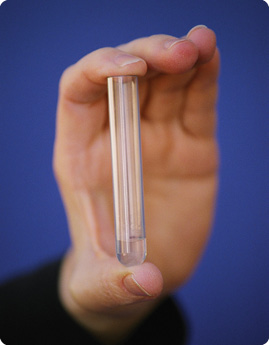On the female side, when it comes to contraception, there’s an arsenal of options. There’s the pill, patches, implants, injectable hormones, sponges, spermicides, cervical caps, diaphragms, morning-after pills, and the intrauterine device.
But when it comes to men, the choices, in comparison, seem paltry—it’s either a condom or a vasectomy. Both have major drawbacks. The condom can break and is reliant on the user’s due diligence, which can sometimes flag in moments of overwhelming ardor. The vasectomy is not easily reversible, leaving many men, understandably, skittish. What if they should one day change their minds?
Now, however, it looks like we may be on the verge of some important breakthroughs in the world of male contraception. New methods are on the horizon, offering the possibility of significantly reducing the number of unwanted pregnancies, not only in affluent nations but in regions with high birth rates and low incomes, such as India and much of Africa.
Some of the most promising research efforts are aimed at interfering with the sperm cells themselves, including drugs that would either prevent them from forming, inhibit their ability to swim, paralyze or pulverize them along the way, or prevent them from reaching or penetrating the ovum. A number of these approaches have already shown very promising results in animals, and at least one, a plant-derived compound in Indonesia, is already undergoing human trials. Work is also being done on simple devices that use either heat or ultrasound applied to the testes to render sperm infertile for a period of months, although some analysts say that these are not likely to become practical methods for widespread use.
The Prized Objective: Long Term and Reversible
There is one method that could potentially provide that much-hoped-for goal of both long term action and reliable reversibility. It has undergone years of testing in India, in nonhuman primates and also in people, and a similar method is being developed under license by a foundation that hopes to be able to begin human trials in the United States in 2015. If all goes well, it may be commercially available sometime in 2017.
Called Vasalgel, it consists of a spermicidal material that is injected directly into the vas deferens, the tube through which sperm must pass after they leave the testes. The material kills the sperm as they pass through, resulting in a completely infertile seminal fluid. The treatment is said to be effective for at least ten years and is reversible through a second injection with a material that flushes out the spermicide, apparently restoring fertility within months.
The Parsemus Foundation, an American nonprofit organization dedicated to advancing innovative and neglected medical research, is behind the development of Vasalgel and in 2014 carried out testing on baboons. This initial testing produced no pregnancies over periods of several months, with each of the eight males allowed to mate with large numbers of females (10–15 each) throughout the period. With sufficient funding, the foundation hopes it can start human trials in 2015.

The Vasalgel polymer material, which is injected under local anesthesia, is a different formulation from the one used in tests for many years in India, called reversible inhibition of sperm under guidance (RISUG). That material has already gone through human trials there with dozens of men and has shown effective contraception for at least six months, and in some cases for years. Tests with monkeys showed it could remain effective for 10–15 years, and effective reversibility was also demonstrated.
Aaron Hamlin, who is the executive director of a recently formed advocacy group called the Male Contraception Initiative, says Vasalgel “seems like it’s the furthest along” of all the methods that might become available, at least in the United States. The basic method “has been in trials in India for decades and has been shown to work for over ten years effectively,” he says. “And they showed it was reversible in primates that had it for over a year.”

Hamlin points out that the procedure itself is “similar to no-scalpel vasectomy” and, like that procedure, can be carried out either through a very small incision or direct injection. That’s a procedure that has been widely practiced successfully for many years and requires only minimal equipment. Furthermore, the polymer material used is inexpensive to produce.
Such a long-lasting approach is an important goal, Hamlin says, since it requires no further action by the user. Many studies have shown wide disparities between the effectiveness of various contraceptive use under ideal conditions of compliance as compared with typical rates. For example, with ideal use, condoms result in just two pregnancies per 100 couples per year who rely on them, whereas under actual typical use, that number soars to 18, he says.
Since about half of all men in a recent poll said they’d like to have the option of a male contraceptive available, the possibility of an effective long term method that is easily reversible “would have a strong appeal,” Hamlin says.
Curbing Male Fertility by Knocking Out the Alpha Gene
There are several other avenues of research that could also lead to effective male contraceptives, based on a number of different ways of trying to thwart the sperm’s quest to find and bind with the ovum. Several of these have shown promising results in the laboratory.

For example, Debra Wolgemuth, a professor of genetics and development at Columbia University Medical Center, is leading a research project aimed at developing retinoic-acid receptor antagonists as a way of curbing male fertility. It has long been known that a deficiency of vitamin A causes infertility in men, but that deficiency of course has many other deleterious health effects. However, it turns out that the same effect can be selectively achieved by blocking only a few, or even just one, of the several pathways that vitamin A goes through in the body as it forms active metabolites.
There are two different kinds of retinoid receptors, Wolgemuth explains, and each of them is governed by three different genes, known as alpha, beta, and gamma. In experiments with mice, “If you knock out the alpha gene,” she says, “the animals are viable, fine, no obvious defects, but the males are sterile.” It turned out to be affecting just one of several steps in a long process the sperm cell goes through in its development, but had no apparent effect on other bodily functions.
To take that insight and turn it into a potential birth control system, Wolgemuth says, required finding a pharmacological way of blocking that same metabolic pathway. It turned out that Bristol Meyers Squibb had developed a drug for other purposes that seemed to interfere with that retinoid pathway but had other negative effects. However, Wolgemuth found that “we could use much lower doses and still get reduced fertility, but we didn’t see any other organ systems being affected. Most importantly, when we took the mice off the drug, it was reversible. And we examined the progeny of these mice, and they were perfectly fine and normal.”
She and her team have continued to lower the doses and are continuing the research, but any human testing is likely still years away. Just as with virtually all nonhormonal pharmaceutical methods being explored, researchers estimate that the actual availability of such methods to consumers, if all goes well, is on the order of five to ten years.
Sink or Swim: From Plant Extracts to Protein Mimicry and More
One that might have a faster timetable is a natural plant substance being tested in Indonesia. It’s an extract of a plant called gandarusa, which is widely planted there and has long had a reputation for medicinal qualities. A particular compound found in the plant has been in clinical trials since 2011 by the company IndoFarma. So far, several hundred couples have tested the drug for extended periods, with a reported success rate of over 99.9%.
Prof. Bambang Wardojo of Airlangga University in East Java says the compound disrupts three different enzymes that have been shown in the laboratory to interrupt the penetration of sperm cells into the ovum. Clinical trials in Indonesia are now in their fourth phase, but no testing of it has been carried out elsewhere so far.
Meanwhile, a different approach is being pursued by a company founded by longtime researcher in reproductive biology Michael O’Rand (Figure 4), a recently retired professor of cell biology at the University of North Carolina, who has spent 40 years studying the mechanisms of fertilization. The name of the company is Eppin Pharma, after the enzyme that is the target of the company’s drug-based approach.

O’Rand says that hormonal approaches to male contraception can work but can be problematic because they interfere with hormonal balance. “What we’re been trying to do is develop a nonhormonal approach,” he says. “The problem for everybody in this area is to find the right target.”
With some support from the National Institutes of Health (NIH), O’Rand and his team have been developing a drug that can block the sperm’s ability to swim. Normally, the head of the sperm, which is coated with a protein called eppin, has a layer of another protein called semenogelin bound to it, O’Rand explains, which keeps the sperm immobile until that layer gets dissolved away by an enzyme called prostate-specific antigen (PSA), releasing them. The new drug mimics the semenogelin layer by binding with the eppin coating, but it is unaffected by the PSA, so the sperm never get released to swim.
O’Rand and his team published research in the journal Science showing that an antieppin vaccination approach worked in monkeys but wasn’t a viable approach for humans because of potential unpredictable failure rates, he says. Instead, they were able to create a drug that mimicked the effect of the antibodies that were generated by the vaccination treatment. “It’s a small organic molecule that binds to the same binding site” as the natural antibody, he explains. “It would do the same thing, but wouldn’t have the problems of the antibody,” he says. Now they are working with a number of possible compounds and are hoping to be able to begin phase-one trials soon, he adds.
Several other potential pathways are being actively pursued and could move to the trial stage in the next few years. One is based on the drug phenoxybenzamine, which interferes with the muscle action responsible for propelling semen through the vas deferens. This produces what has been called a dry orgasm, with no ejaculate produced. The original drug has side effects, but researchers are developing a variant that seems to avoid those. Potentially, such a drug could also curtail semen-borne diseases.
Others are working on possible injectable approaches such as gamendazole, which has been tested in monkeys in work supported by the NIH. The initial tests showed 100% effectiveness in rats, with full reversibility, and have shown reversible sperm reduction in monkeys as well. Another contender is a drug called JQ1, which targets the gene BRDT, the Bromodomain testis-specific protein that is important for sperm production. In animal trials, it took six weeks to take effect and then one to three months to regain fertility after discontinuing it. These initial findings were made while testing the drug for other purposes, and a compound specifically formulated for contraceptive purposes is under development.
Other research being conducted in India has shown that calcium chloride injected directly in the epididymis can permanently eliminate sperm while not affecting testosterone levels. This method has been used successfully in dog and cat sterilization. Research in rats toward contraceptive use is ongoing.
Numerous other approaches are also being investigated, and there’s no telling which of these, if any, will truly produce the kind of predictable, safe, effective, and simple-to-use male contraceptive that so many have been seeking. But progress remains slow in the field, says Hamlin of the Male Contraceptive Initiative. “The big thing that male contraception needs is funding— clinical trials cost millions of dollars,” he says, and one goal of his group is to raise awareness and push for more research into promising alternatives.
The availability of another set of practical options for family planning could become an ever more important global need. “The world population can’t continue to grow the way it is, that’s a no-brainer,” says Wolgemuth. “The more options there are, the more we’ll have a chance to really begin to control the world’s population.”



